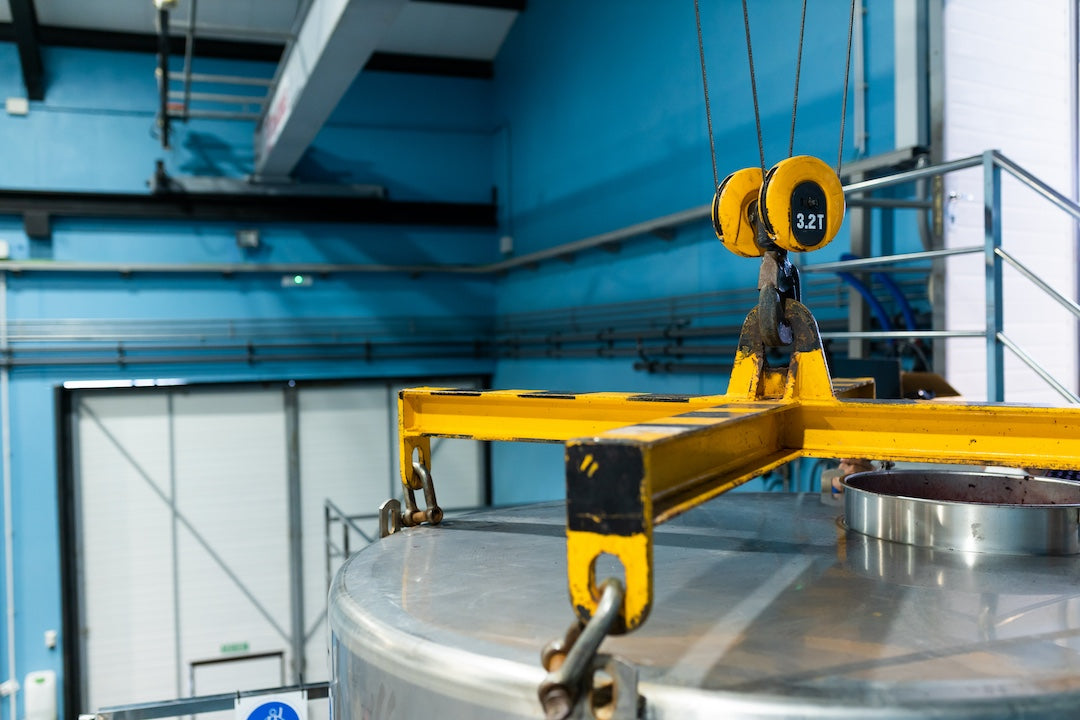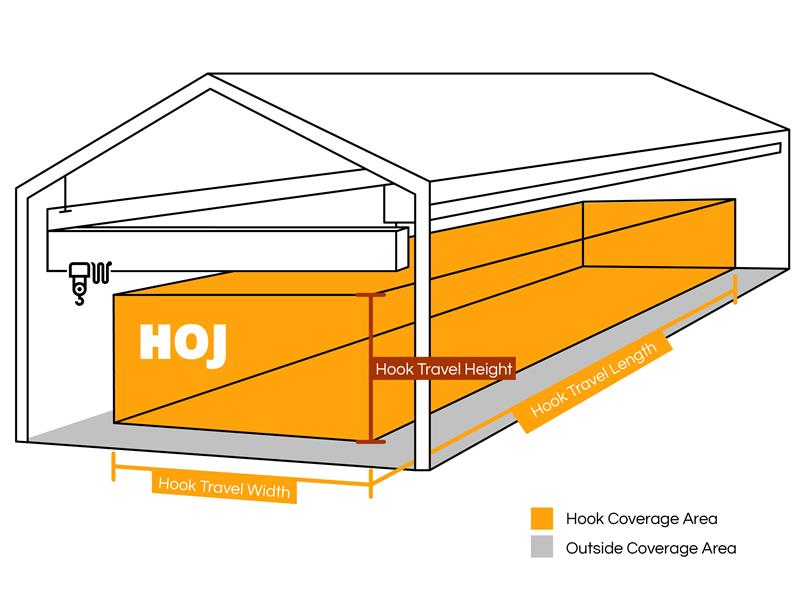Your Cart is Empty

What Is a Hoist? Types, Applications & Safety | Expert Guide
What is a Hoist?

Introduction
Ahoist is a mechanical device used to raise or lower loads via rope or chain wrapped around a drum or lift wheel. Practically, hoists provide vertical lifting for heavy objects using manual, electric, pneumatic, or hydraulic power. They're crucial for safely handling heavy materials in industries like manufacturing, warehousing, construction, and mining, significantly boosting productivity.
Significantly, hoists differ from cranes. A hoist exclusively moves loads vertically, whereas cranes enable multi-directional movement. Often, cranes incorporate hoists to handle vertical lifting while the crane's structure provides horizontal travel. Simply put, a hoist lifts; a crane lifts and moves.
Core Components
A typical hoist consists of several key components, each with specific functions:
Hook:
A forged steel lifting hook connects the hoist to the load, usually through a sling or bail. Typically equipped with a safety latch to prevent detachment, the hook securely engages the load.

Lifting Medium (Chain/Wire Rope/Synthetic Rope):
This flexible element bears the load's weight. Common types include high-strength load m chains, wire ropes, or synthetic ropes for special applications. Chains offer robustness for frequent use; wire ropes handle higher lifts smoothly by spooling neatly onto drums.
Drum or Lift Wheel:
A cylindrical spool or grooved wheel around which the lifting medium winds during load raising or lowering. This component converts the motor's rotational movement into vertical lifting action, ensuring smooth operation and proper winding.
Motor and Gearing System:
Powered hoists use electric or air motors coupled with gearboxes that multiply torque and reduce speed, enabling heavy lifting with minimal effort. Integral braking systems (e.g., electromagnetic brakes) engage automatically to secure loads when power is stopped.
Control System:
The interface enables operator control and safety. Powered hoists typically use pendant push-button or wireless remote controls, along with safety limit switches, to prevent excessive travel. Manual hoists utilize hand chains or levers with internal pawls or brakes to control motion and ensure load security.
Frame/Body:
The structural enclosure housing the motor, gearbox, drum, and internal mechanisms. Frames offer mounting versatility—such as beam hooks, lugs, trolleys, or wall mounts—and must withstand lifting forces, ensuring durability and safe operation.
Each component is essential: motors and gears supply lifting force, drums and ropes/chains manage lifting, hooks engage loads, controls manage operations, and frames securely integrate these elements.
Types of Hoists
Hoists come in several main types based on their power source and structure: manual, electric, pneumatic, and hydraulic. Each offers distinct benefits and is suited to specific applications:
Manual Hoists (Chain or Lever):
Operated manually via a hand chain or lever. Advantages include simplicity, portability, and no need for external power, making them cost-effective for occasional lifts or areas without electricity. Ideal for maintenance tasks, small workshops, minor construction lifts, and hazardous locations (no sparks or heat).
Electric Hoists (Chain or Wire Rope):

Powered by electric motors, these are common in industrial settings. Available with load chains or wire ropes, electric hoists offer increased lifting speed, capacity, precise control, and reduced operator fatigue. Typically used in factories, warehouses, and repetitive lifting environments. They require an electrical supply and regular maintenance, but this greatly improves productivity.
Pneumatic Hoists (Air-Powered):
Driven by compressed air, these hoists feature an air motor that powers gearing. Benefits include suitability for continuous operation, no electrical sparks (safe for explosive atmospheres), excellent cooling, and smooth control. It is ideal for industries like oil and gas, chemicals, paint booths, and workshops with existing compressed air systems. Drawbacks include noise and the need for a robust compressed air infrastructure.
Hydraulic Hoists:
Use hydraulic fluid pressure to lift loads via pistons or motors. Less common but vital for heavy-duty tasks due to their compact, high-capacity performance and precision. Resistant to harsh environments like marine or underwater operations. Common in shipyards, heavy construction, mining, and offshore rigs, where hefty loads demand precise control. They need hydraulic pumps and fluid maintenance, reserving their use primarily for high-capacity scenarios.
Selecting the right hoist type involves matching its strengths—simplicity and portability (manual), efficiency and versatility (electric), safety and endurance (pneumatic), or power and precision (hydraulic)—to your specific lifting needs.
Hoist vs. Crane
While both are distinctly different in function, both are incomplete without the other. A hoist is not a hoist without a crane and vice versa. A hoist is specifically designed for vertical lifting—raising or lowering loads in a straight line. In contrast, a crane is more complex, providing multi-directional movement. Cranes typically include a hoist for vertical lifting plus additional parts, such as a trolley and bridge or boom, for horizontal motion.

Applications and Industries
Hoists are used across a wide array of industries wherever heavy lifting is required. Below is a compressed list of major application areas and examples of how hoists are utilized in each:
-
Manufacturing: Factories and workshops use hoists to lift machinery, parts, and tooling. For instance, automotive plants often mount electric chain hoists on overhead rails to position engines or transmissions accurately. Hoists offer precise vertical control, making them essential in diverse manufacturing environments, from metal fabrication to food processing.
-
Warehousing and Logistics: Warehouses and distribution centers use hoists, often with cranes or monorails, to vertically lift heavy inventory onto mezzanines, trucks, or containers, enhancing safety and efficiency.
-
Construction: Hoists are widely used in construction for lifting building materials and personnel. Temporary material hoists raise bricks, beams, and tools; tower cranes use winches for heavy loads, and personnel hoists carry workers to upper levels, enabling efficient vertical transportation on-site.
-
Mining: Mine hoists (winders) are crucial in mining, raising ore from deep shafts and lowering equipment and workers underground. Engineered for heavy, continuous duty, they significantly improve safety and reduce manual labor by efficiently handling vertical transport of materials and personnel. Smaller hoists also handle surface maintenance tasks.
-
Automotive, Aerospace, and Shipbuilding: Heavy industries rely on hoists for assembling large components. Automotive plants use electric hoists to lift engines and car bodies; aerospace facilities handle aircraft parts like jet engines and landing gear; shipyards employ high-capacity hoists within gantry cranes to position massive ship modules precisely.
In summary, anywhere heavy lifting is needed – from the factory floor to construction sites, mines deep underground, or massive shipyards –hoists find application. They improve safety by doing the heavy lifting mechanically, and they improve productivity by moving loads more quickly and accurately than manual methods.
Duty Service and Standards
Hoists vary based on intended usage—from light, occasional lifts to heavy, continuous service—categorized by standards from the Hoist Manufacturers Institute (HMI), American Society of Mechanical Engineers (ASME), and regulated by OSHA.
For instance, HMI duty classes range from H1 (rare use) to H5 (continuous industrial use), based on lifts per hour, average load, and daily operation. ASME's B30 standards guide hoist design, inspection, and safety, while OSHA mandates workplace compliance with these standards. Choosing a hoist with the right duty rating and adhering to inspections ensures safety, equipment longevity, and regulatory compliance.
Safety Guidelines
When using hoists, safety is paramount. Accidents can be catastrophic given the weights involved, so strict guidelines are followed. Key safety practices include:
-
Regular Inspections: Hoists require routine checks, including pre-use visual inspections (hooks, chains, ropes, and controls) at each shift or use, plus periodic detailed examinations by qualified personnel. Regular inspections identify issues, such as bent hooks or frayed ropes, before they lead to failures. Regulations, such as OSHA, mandate thorough annual inspections, with more frequent checks for heavy-use hoists, to ensure safe and reliable operation.
-
Operational Precautions: Operators must follow safe procedures, never exceed rated load capacities, and secure loads properly to ensure safe operation. Always keep the area beneath clear, lift vertically without side-pulling, and avoid jerking movements. Ensure safety features, such as limit switches, function properly. Adhering strictly to manufacturer guidelines and standards (ASME B30.16, OSHA) significantly reduces accident risks.
-
Training and Certification: Only personnel who are trained should operate hoists. Basic training covers proper use, signaling, weight estimation, and emergency procedures, while industrial overhead hoists often require OSHA or HMI-certified training programs. Certain hoists, like tower cranes or personnel hoists, mandate licensed operators. Maintenance staff also need training in lockout/tagout procedures. Proper training significantly reduces equipment misuse and enhances safety.
-
Common Risks and Preventive Measures: Hoist hazards include overloading, mechanical failure, and human errors. To prevent these, hoists feature overload protection like slip clutches, require regular maintenance, and use safe rigging methods. Operators must maintain a safe distance, plan lifts carefully, and use appropriate rigging equipment. Safety features like load limiters, emergency stops, and personal protective gear further mitigate risks.
In essence, safe hoist operation boils down to:inspecting often, operating within limits, training your people, and anticipating risks. Companies that enforce these guidelines see far fewer incidents and more efficient lifting operations.
Factors for Hoist Selection
Choosing the right hoist for your needs requires evaluating several factors. Below is a list of key selection criteria and why they matter:
-
Load Capacity: Choose a hoist rated above your maximum lifting requirement, ideally by about 20% extra, ensuring safe operation and equipment longevity. Overloading reduces safety and shortens hoist lifespan, so always match tonnage appropriately to tasks.
-
Lift Height and Speed: Ensure your hoist's lifting height meets required distances, including extra cable/chain length and appropriate headroom. Lift speed impacts efficiency: frequent, high lifts favor faster hoists, while precision tasks prefer slower models. Heavier hoists typically lift slower. Choose speed and height based on your workflow demands.
-
Duty Cycle (Usage Frequency): Duty cycle indicates how frequently and intensely a hoist is used, categorized by HMI or FEM duty classes. Choose a high-duty hoist (H4 or above) for continuous, heavy workloads, or a lower-duty hoist (H2) for occasional, lighter use. Matching the hoist's duty class to your workload prevents overheating and premature wear.
-
Environmental Conditions: Select a hoist suited to your operating environment. Outdoor use demands rugged, weather-resistant construction; corrosive sites require stainless steel or special coatings; extreme temperatures need hoists rated for cold or heat; dusty or wet conditions benefit from sealed motors and protected enclosures. Explosive atmospheres necessitate explosion-proof or spark-resistant hoists. Matching hoist features to environmental demands ensures safety and equipment longevity.
-
Power Source: Choose a hoist matching available power sources: electric hoists require stable electricity (120V single-phase or 230/460V three-phase), pneumatic hoists need sufficient compressed air, and manual hoists rely on human power. Remote sites may necessitate manual or gas-powered hoists. Consider energy costs, convenience, existing infrastructure, and safety needs—electric hoists are common in factories, pneumatic hoists suit explosive environments. The chosen power type impacts installation and operating expenses.
-
Cost vs. Performance: Balance budget with performance needs. Although cheaper hoists save upfront costs, undersized or low-duty models risk early failure and safety issues. Investing in higher-quality or heavier-duty hoists typically delivers longer lifespan and fewer breakdowns. Consider total ownership costs—maintenance, downtime, warranty, parts availability, and manufacturer reputation—rather than just the initial price.
By carefully considering these factors – capacity, lift height/speed, duty cycle, environment, power type, and cost-performance tradeoffs – you can select a hoisting solution that is safe, efficient, and economical for your specific application.
Historical Context
Hoisting has existed for thousands of years as humans sought to exceed natural strength limits. Ancient Egyptians (2000–4000 B.C.) employed simple rope-and-lever mechanisms for lifting water and building structures, including drawbridge-like devices in fortresses. Greeks and Romans enhanced hoisting by inventing block-and-tackle systems—Archimedes notably used compound pulleys to move ships, while Romans created early elevators powered by human or animal-driven winches.
The Industrial Revolution dramatically advanced hoisting technology. In 1846, Sir William Armstrong invented a hydraulic crane, demonstrating powerful lifting capabilities. In 1852, Elisha Otis introduced the safety elevator with a braking system, transforming passenger lifts. By 1880, Werner von Siemens had developed the first electric-powered elevator, confirming the reliability of electricity for lifting tasks.
In the early 20th century, hoists became widely available industrial products. Alfred K. Box introduced the compact, affordable "Load Lifter" electric hoist in 1921. Shaw-Box launched the portable Budgit electric chain hoist in 1935, enhancing flexibility. Throughout the century, hoist design has improved significantly with the use of advanced materials, standardized safety features, and precise electrical controls.
Recent innovations include electronic controls and variable-speed drives, enablingsmoother load handling and reduced electrical strain. Hoists now integrate IoT connectivity and sensors for real-time monitoring and diagnostics of loads and maintenance schedules. Lightweight composite materials and ergonomic designs also enhance ease of manual operation.
From ancient rope-and-pulley contraptions to today's intelligent electric hoists, the evolution of the hoist reflects humanity's continual pursuit of lifting heavier, higher, and safer. Each milestone – be it the introduction of the safety brake, hydraulic power, electric motors, or computerized controls – has made hoists more reliable and indispensable in our world of construction and industry.
Maintenance and Troubleshooting
Keeping a hoist in safe working order requires regular maintenance and being alert to common issues. Here is a very concise overview:
-
Routine Inspections: Routine hoist inspections include checking chains or ropes for wear and stretching, inspecting hooks and safety latches for damage, monitoring gearboxes and motors for unusual sounds, and testing brakes and limit switches. Companies often use daily checklists supplemented by annualtechnician inspections. Regular lubrication of moving components is also essential.
-
Common Issues & Solutions: Common hoist issues include lifting medium wear (replace chains or ropes promptly), failure to lift or lower due to electrical or mechanical faults (stop use, consult technician), and overheating motors from overload or brake issues (allow cooling, adjust brake or upgrade unit). Drifting loads typically indicate brake problems needing adjustment or replacement. Vibrations or unusual noises indicate gear or alignment issues that require immediate maintenance. Always remove hoists from service at the first irregularity to prevent further damage.
-
Recommended Schedules: Adhere strictly to the manufacturer's maintenance schedule, including frequent visual checks (daily or weekly) and detailed periodic inspections (monthly to yearly based on usage). Critical parts like load chains typically have defined replacement intervals. Schedule at least annual servicing by a qualified technician for gearbox oil changes, overload calibration, electrical inspections, and brake checks. Heavy-use hoists may need more frequent checks. Always maintain detailed maintenance logs for compliance and troubleshooting.
By doing regular maintenance and addressing issues promptly, you'll ensure your hoist operates safely and has a long service life. Well-maintained hoists seldom fail unexpectedly – the key is vigilance and adherence to service intervals.
Conclusion
Hoists are essential tools, safely providing the muscle needed for efficient vertical lifting. Correctly understanding their use, selecting suitable types and capacities, and maintaining them properly ensures productivity and worker safety.
From ancient ropes to modern smart devices, the fundamental purpose of hoists—lifting heavy loads—remains unchanged. With proper knowledge and safety measures, hoists are powerful partners in industrial lifting tasks.
Whether you need a hoist, a bridge crane, or both, Hoj Innovations will help you find the perfect solution tailored to your unique needs. Reach out today!








